In English pubs and Belgian and Dutch beer cafés, it’s a common sight: First, the barkeeper dips the tap into the foam producing a lively mixture in the beer glass, then they pour off any excess foam and finally they skim across the rim of the glass with a spatula in order to ensure that anything even resembling a foamy head is removed.
Different strokes for different folks. But it’s a sight that would break many a German brewer’s heart, because they work really hard to produce strong, stable and lasting foam. Foam is both a distinctive and a technically challenging feature of German beer styles. And hops play a key part in the process.
One of the foam-friendly substances is CO2, without which no foam would form at all. CO2 is the disperse phase, in other words the matter that is finely spread throughout the dispersion medium that is the beer, but is not dissolved in it and therefore provides the necessary action. When the beer is poured, the pressure release causes the CO2 to rise to the surface taking all sorts of hydrophobic particles with it and forming foam. The framework of the foam is made up of polypeptides (protein chains) from the malt and bitter acids from the hops that act as bridge-builders between the proteins. Scientists assume that the interconnection and cohesion result from the hydrophobic and dipole interactions of their constituent substances. Without the bitter acids as the creative partners of the polypeptides there would be no foam.
The art of foam begins with the mash. The foam requires larger (i.e. high-molecular-weight) proteins, while the yeast metabolizes smaller (i.e. low-molecular-weight) protein fractions in the form of amino acids. Therefore, the malt quality and the mash program have to be matched. For example, brewers skip the protein rest by using highly modified types of malt so that the protein fraction particles in their wort do not become too small and to ensure that there is enough material present for ideal foam formation.
In the kettle, the right hop quantity and composition is important, as is the staggering of the hop addition. This is because not only the iso-alpha acid but also the alpha acid acts as a bridge-builder. Various secondary bitter substances such as isoadprehumulone and reduced iso-alpha acids (tetrahydro-iso-alpha acid) also promote foam stability. It has been shown that unhopped beers do not foam, whereas beers to which iso-alpha acids have been added do. Satisfactory foam adhesion has been achieved with iso-alpha acid addition of as little as 10 ppm, for example.
The yeast can spoil the foam party, however, if it suffers stress due to a lack of low-molecular-weight proteins, a high concentration of CO2 or alcohol, or excessive pressure, for example. Such stress causes it to secrete enzymes (proteinase A) that break down the foam-friendly, high-molecular-weight proteins. Fatty acids are also critical. Due to their hydrophobicity, they displace other foam-friendly substances from the gas bubble surface, but do not themselves form a stable film. Such foam-negative lipids are produced endogenously at low mash temperatures and during poorly controlled fermentation or arise exogenously in finger or lip marks on beer glasses. Detergent residue also reduces surface tension. And too much ethanol dehydrates and breaks up the liquid film.
Good foam, in other words, is something for experts who master the interplay of many elements. Life is easier for brewers outside Germany. They are allowed to use brewing aids that are forbidden by the German Beer Purity Law, such as the hop products Tetrahop and Hexahop from BarthHaas. These products contain tetrahydro- and hexahydro-iso-alpha acids that are not found in hop cones, pellets, or extracts. These hydrated and reduced iso-alpha acids feature greater hydrophobicity than natural iso-alpha acids and have a positive effect on foam formation, stability and adhesion. Yes, foam can be that simple! But that’s certainly no reason to simply skim it off in the pub.


